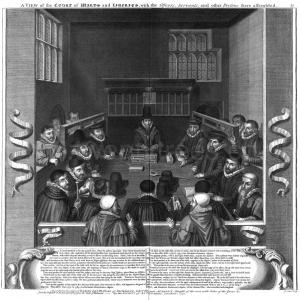Vetusta Monumenta Volume 1
Vetusta Monumenta Volume 1 is in Vetusta Monumenta.
Vetusta Monumenta Volume 1 was published in 1747.
Culture, England, Societies, Society of Antiquaries of London Publications, Vetusta Monumenta Volume 1 Plate 1 Bronze Lamp
Plate 1. Engraving of a Bronze Lamp found at St. Leonard's Hill, Windsor
Plate 1 of Vetusta Monumenta depicts a medieval bronze lamp, likely dating from the thirteenth or fourteenth century, with circular base added in the eighteenth century. The lamp was originally thought to be Roman when it was discovered c. 1705. Engraving by George Vertue after John Talman. 236 x 184 mm. Published by the Society of Antiquaries of London in 1718. Current location: Society of Antiquaries of London (LDSAL 59), London, UK.
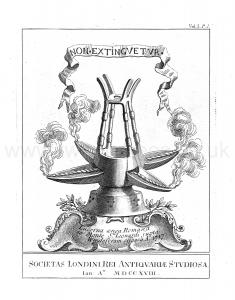
Minutes of the Society of Antiquaries. 14 Jan 1719. It was proposed by Mr President (age 57) wheather every subscriber to the Plate of Richard II have each five prints, and by Ballot carried in the Affirmation, for their 7s:6d.
It was ordered that the Right Reverend Father in God the Bishop of Rochester & Dean of Westminster (age 55), for giving leave to take the Drawing be presented with two of the said prints, and that Mr Director (age 41) and Mr Treasurer (age 36) be desired to wait upon him on that Amount.
Mr Director (age 41) brought in a proof of an Etched Plate of a Roman Lamp, to be used as a Symbol or Ticket of the Society which he was pleased to make a present of to the Society for which their unanimous thanks were ordered to be given to him.
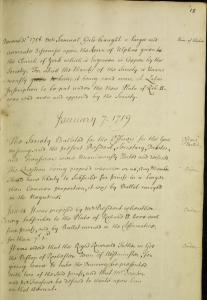
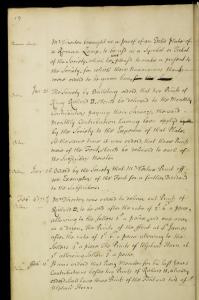
Minutes of the Society of Antiquaries. 18 Feb 1819. Mr Kirk Patrick brought the seals of all of the Bishops of Norwich curiously drawn by himself from the originals which he designs for the Press.
Mr Vertue was ordered to print off 100 more of Rich: II, and 100 more of the Lamp; and he is desired to add the Inscription according to the Copy delivered to him if Mr Director approves of it.
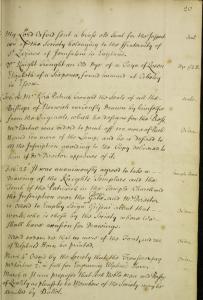
Culture, England, Societies, Society of Antiquaries of London Publications, Vetusta Monumenta Volume 1 Plate 2 Horn of Ulf
Plate 2. Engraving of The Horn of Ulf.
Plate 1.2 of Vetusta Monumenta depicts an early eleventh-century Viking charter horn made from elephant tusk (possibly by Islamic craftsmen) in Salerno, Italy, with new silver mounts added in 1675. The horn was given to York Minster [Map] c. 1036 to symbolize a gift of land from Ulphus or Ulf Toraldsson. Engraving by George Vertue after B. M. 281 x 389 mm. Published by the Society of Antiquaries of London in 1718. Current location: York Minster, York, UK [Map].
Above the Horn: Cornu antiquum Icone hac duplò undique ad amussim majus, in Templo D. Petri. Ebor. asservatur A.D. MDCCXVIII. Ecclesiӕ, uti creditur, sub initio Sӕculi XI oblatum. [An ancient horn in all respects exactly twice the size of this image, in the Church of St Peter, York. Recorded in the year 1718. It is believed to have been bestowed on the minster at the beginning of the 11th century.]
Center, Left: A / CORNV HOC VLPHVS IN OCCIDENTALI PARTE DEIRӔ PRINCEPS VNA CVM OMNIBVS TERRIS ET REDDITIBVS SVIS OLIM DONAVIT AMISSVM VEL ABREPTVM. [Ulf, ruler of the western region of Deira, gave [the Church] this horn—which for a time was lost or stolen—together with all his lands and incomes.]
Center, Right: B / HENRICVS D.SFAIRFAX DEMVM RESTITVIT DEC & CAP. DE NOVO ORNAVIT AN.o DOM. 1675. [Henry, Lord Fairfax, eventually restored it. The dean and chapter decorated it anew in the year 1675.]
Bottom: Ex Collectione Samuelis Gale. / Sumptibus Societatis Antiquariӕ Lond [From the collection of Samuel Gale. / At the expense of the Antiquarian Society Lond[on]
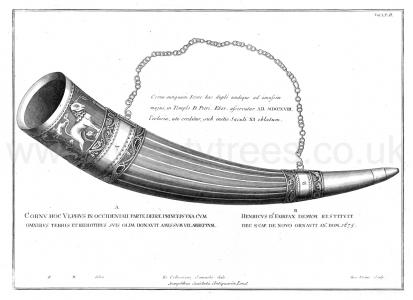
Culture, England, Societies, Society of Antiquaries of London Publications, Vetusta Monumenta Volume 1 Plate 3 St James' Font
Plate 1.3: Engraving of the Baptismal Font at St. James's, Piccadilly.
Plate 1.3 of Vetusta Monumenta depicts a marble baptismal font at St. James's Church, Piccadilly, presumed to be carved by Grinling Gibbons (age 69) in 1685. Engraving by George Vertue (age 34) after Charles Woodfield. 457 x 283 mm. Published by the Society of Antiquaries of London in 1718. Current location: St. James's Church, Piccadilly, London, UK.
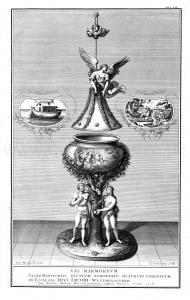
Minutes of the Society of Antiquaries. 21 Jan 1719. The Society by Balloting ordered that two prints of King Richard II should be delivered to the Monthly Contributors paying their Arrears the said Monthly Contribution having been applyed by the Society to the Expense of that Plate.
At the same time it was ordered that three Prints more of the Font should be delivered to each of the Subscribers thereto.

Minutes of the Society of Antiquaries. 28 Jan 1719. Ordered by the Society that Mr George Vertue (age 35) Print off 100 Exemplar of the Font for a further Dividend to the Subscribers.

Minutes of the Society of Antiquaries. 04 Feb 1719. Mr Director (age 41) was ordered to deliver out prints of Richard II to be sold after the rate of 2s:6d a peice [sic], allowing to the sellers 6d a peice [sic], and one over in a dozen. The Prints of the Font of St James after the rate of 1s:6d a peice allowing to the seller 4d a piece. The prints of Ulphus's Horn at 1s allowing Seller 3d a peice [sic].

Culture, England, Societies, Society of Antiquaries of London Publications, Vetusta Monumenta Volume 1 Plate 4 Richard II
Plate 1.4: Engraving of a Portrait of Richard II in Westminster Abbey
Plate 1.4 of Vetusta Monumenta reproduces a portrait (c. 1395) of Richard II in Westminster Abbey, the earliest known portrait of an English monarch. The engraving preserves design elements lost when the painting was restored in 1866, but also gives a more idealized representation of the monarch's features than does the portrait itself. Engraving by George Vertue (age 34) after Giuseppe Grisoni (age 19). 537 x 265 mm. Published by the Society of Antiquaries of London in 1718. Current location: Westminster Abbey, London, UK.
Giuseppe Grisoni: On or before 24 Oct 1699 he was born. He was baptised on 24 Oct 1699. In 1715 Giuseppe Grisoni travelled to London with John Talman and tried to establish himself as a portrait painter. He did not achieve enough success to stay, however, and returned to Florence in 1728. In 1769 he died.
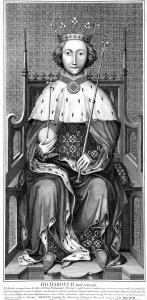
Minutes of the Society of Antiquaries. 05 Feb 1718. It ws proposed for the first time by Mr President Norroy (age 57) to engrave a drawing of Richard II's picture in Westminster Abbey taken by Mr Talmans (age 40) direction agreed to.
Mr George Holmes (age 56) is to do [?] to keep the books belonging to the Society till further order.
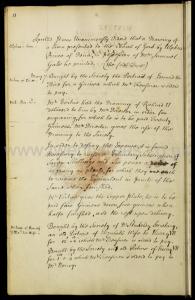
Minutes of the Society of Antiquaries. 12 Feb 1718. Mr Samuel Gale (age 35) Treasurer is authorized to pay Mr Vertue (age 34) two guineas toward engraving the font of St James church. It is proposed for the second time to engrave RII'd's picture and agreed.

Minutes of the Society of Antiquaries. 19 Feb 1718. It is proposed and agreed the 3rd time to engrave RII picture in Westminster Abbey and Mr Director Talman (age 40) is desired and authorised to have a drawing tken of it with all convenient speed, in order thereto.

Culture, England, Societies, Society of Antiquaries of London Publications, Vetusta Monumenta Volume 1 Plate 5 Medieval Seals
Plate 1.5: Engravings of Three Medieval Seals
Plate 1.5 of Vetusta Monumenta depicts three medieval seals: the Seal of Clare College, Cambridge (1359), the seal of the Cathedral Priory of St. Etheldreda, Ely [Map] (c. 1280), and seal of the Priory of Cottingham [Map] (1322) [Note. The date here somewhat confusing since the Priory was founded in 1325?]. Engraving by George Vertue after his own drawings. 173 x 233 mm [upper portion] and 172 x 228 mm [lower portion]. Published by the Society of Antiquaries of London in 1720. Current locations: The top seal is in Clare College, Cambridge University, Cambridge, UK; an impression of the center seal is in Westminster Abbey (WAM 7933), London, UK; the bottom seal is in the British Museum (1913,1105.2), London, UK.
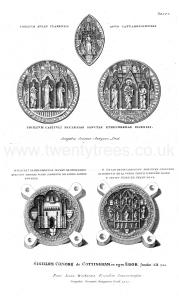
Culture, England, Societies, Society of Antiquaries of London Publications, Vetusta Monumenta Volume 1 Plate 6 Walsingham Priory
Plate 1.6: Engraving of the Ruins of Walsingham Abbey [Map].
Plate 1.6 of Vetusta Monumenta depicts the ruins of Walsingham Abbey in Norfolk, including some remains which are no longer standing. This topographical print is the earliest example of a more popular approach in Vetusta Monumenta, reflecting a taste for landscapes with ruins. Engraving by Gerard Vandergucht after J. Badslade. 135 x 257 mm. Published by the Society of Antiquaries of London in 1720. Current location: Little Walsingham, Norfolk, UK.
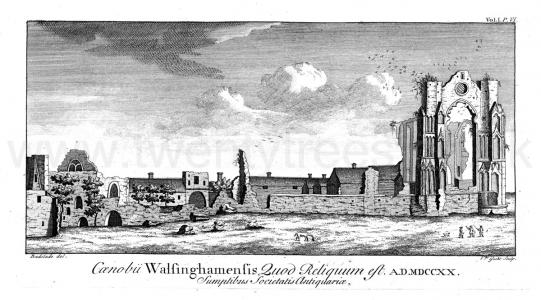
Culture, England, Societies, Society of Antiquaries of London Publications, Vetusta Monumenta Volume 1 Plate 7 Waltham Cross
Plate 1.7: Engraving of Waltham Cross [Map]
Plate 1.7 of Vetusta Monumenta depicts the Waltham Cross, one of the twelve monuments that Edward I ordered to be built between 1291 and 1294 to commemorate the funeral procession of Queen Eleanor. The print documents the early preservation efforts of the Society of Antiquaries of London. The cross was re-engraved by James Basire Sr. after Jacob Schnebbelie for the third volume of Vetusta Monumenta (Plate 3.16), where it appears with two more of the Eleanor Crosses. Engraving by George Vertue (age 37) after William Stukeley (age 33). 490 x 301 mm. Published by the Society of Antiquaries of London in 1721. Current location: Waltham Cross, Hertfordshire, UK.
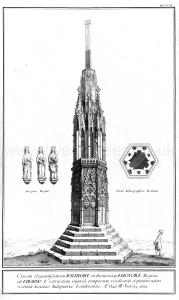
Culture, England, Societies, Society of Antiquaries of London Publications, Vetusta Monumenta Volume 1 Plate 8 Roman St Albans
Plate 1.8: Engraving of a Plan of Ancient Verulamium [Map]
Plate 1.8 of Vetusta Monumenta features an extensively labeled map of the Roman remains of Verulamium with inset images of two ancient British coins and a section of Roman wall. Engraving by George Vertue after William Stukeley. Published by the Society of Antiquaries of London in 1721. Current location: Stukeley's original map is preserved at the Society of Antiquaries of London; the Roman ruins today are encompassed by the modern city of St. Alban's in Hertfordshire, UK.
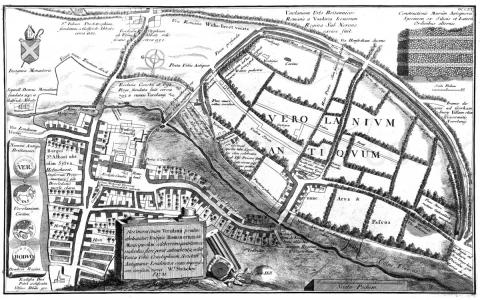
Culture, England, Societies, Society of Antiquaries of London Publications, Vetusta Monumenta Volume 1 Plates 9-12 Fountains Abbey
Plates 1.9 - 1.12: Engravings of the Ruins of Fountains Abbey [Map]
Plates 1.9-1.12 of Vetusta Monumenta depict the ruins of the twelfth-century abbey church of Fountains, Yorkshire, with extant monastic structures. The images offer significant visual evidence of the site as it stood in 1722, recording subsequently lost fabric, including the late twelfth-century cloister arcades, the tracery of the main windows of the abbey, the presbytery arcades and high altar enclosure. Engravings by George Vertue (age 39) after Samuel Buck. Published by the Society of Antiquaries of London in 1723. 190 x 367 mm, 189 x 364 mm, 192 x 370 mm, and 194 x 371 mm. Current location: Fountains, Ripon, North Yorkshire, UK.
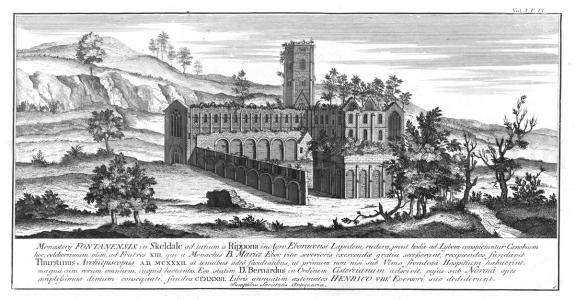
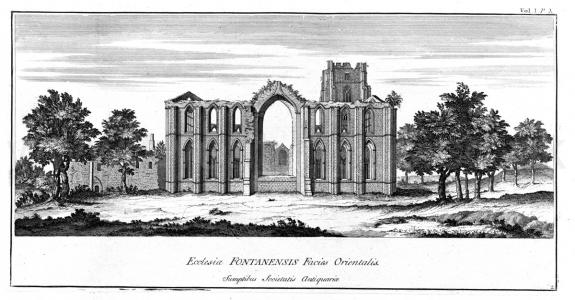
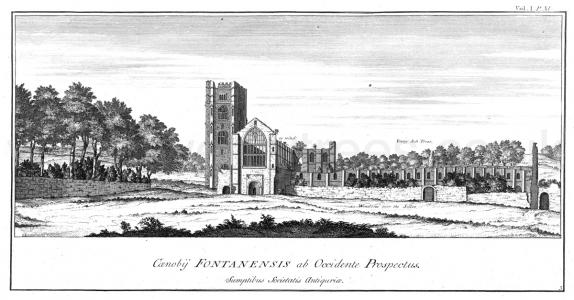
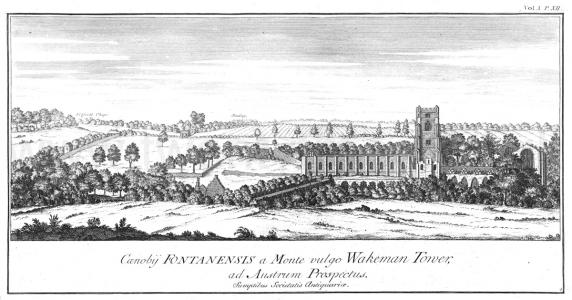
Culture, England, Societies, Society of Antiquaries of London Publications, Vetusta Monumenta Volume 1 Plates 13 and 14 St Benets Gatehouse
1724.Plates 1.13 and 1.14: Engravings of St. Benet's Abbey Gatehouse [Map] (1 of 2) by George Vertue (age 40) after John Kirkpatrick and Edmund Prideaux (age 30). 205 x 389 mm and 206 x 318 mm. Published by the Society of Antiquaries of London in 1724.
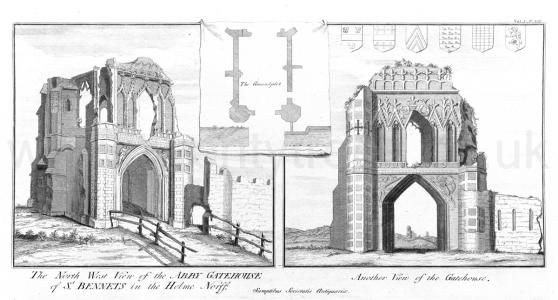
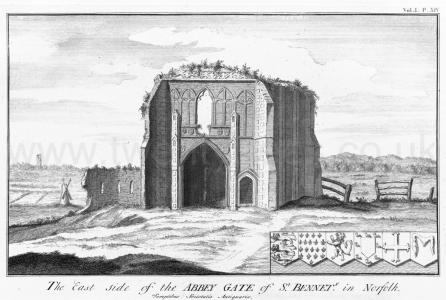
Culture, England, Societies, Society of Antiquaries of London Publications, Vetusta Monumenta Volume 1 Plate 15 Tomb of Robart Colles
1724. Plate 1.15: Engraving of the Tomb of Robart Colles. Late fifteenth or early sixteenth-century chest tomb of Robart Colles in the Holy Innocents Church, Foulsham [Map]. Paneled sides around which runs the inscription "Robart Colles Cecili his vif." Engraving by George Vertue (age 40) after Edmund Prideaux (age 30). 204 x 328 mm.
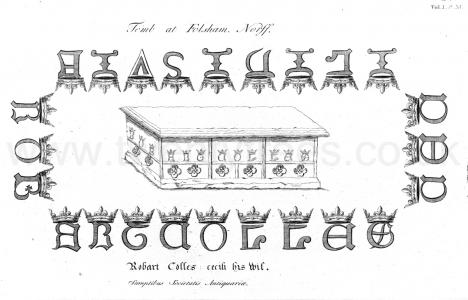
Culture, England, Societies, Society of Antiquaries of London Publications, Vetusta Monumenta Volume 1 Plate 16 Shrine of Edward the Confessor
1724. Plate 1.16. Engraving of the Shrine of Edward the Confessor at Westminster Abbey [Map]. Thirteenth-century shrine base and feretory canopy of St Edward at Westminster Abbey. Engraving by George Vertue (age 40) after John Talman (age 46). 445 x 336 mm (bifolium).
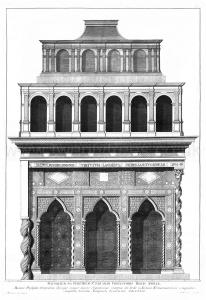
Culture, England, Societies, Society of Antiquaries of London Publications, Vetusta Monumenta Volume 1 Plates 17
1725. Plate 1.17: Engravings of Whitehall and King Street Gates. The "Holbein Gate [Map]" (completed in 1532), and the King Street Gate (completed c. 1548). Engravings by George Vertue (age 41) after his own drawings.
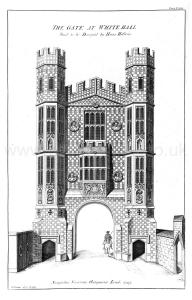
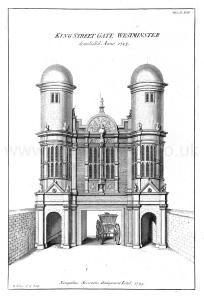
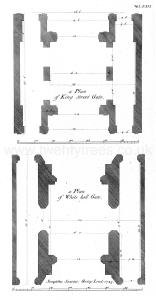
Culture, England, Societies, Society of Antiquaries of London Publications, Vetusta Monumenta Volume 1 Plate 20 Tudor Medals
1731. Plate 1.20: Engravings of: A silver crown of Henry VIII around 1545, a Coronation 1547 Medal of Edward VI, a 1589 "Dangers Averted" or "Armada Medal" of Elizabeth I, the Phoenix Jewel (c. 1570-1580) of Elizabeth I from around 1570-1580 along with the motto from a 1574 silver medal of the same, and a struck gold medal of James I commemorating the 1604 Peace with Spain. Engraving by George Vertue (age 47) after his own drawings
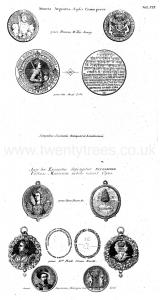
Culture, England, Societies, Society of Antiquaries of London Publications, Vetusta Monumenta Volume 1 Plates 21 to 26 Westminster Tournament Roll
1726. A nearly sixty-foot vellum roll that illustrates the jousting tournament held by Henry VIII on 12 and 13 February 1510/11, along with the "articles of the tilt". Engravings by George Vertue (age 42) after the original manuscript.
A description of the Solemn Jousts held at Westminster the 13th day of February in the first year of King Henry VIII in honour of his Queen Katherin upon the birth of their eldest son Prince Henry AD 1510 taken from the original roll now in the College of Arms, London.

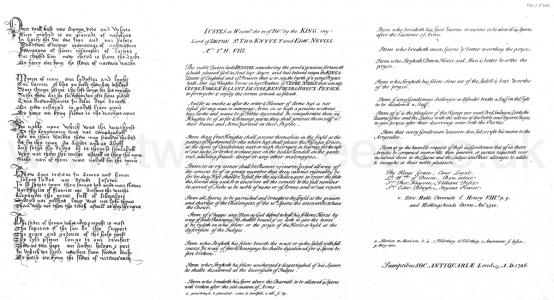
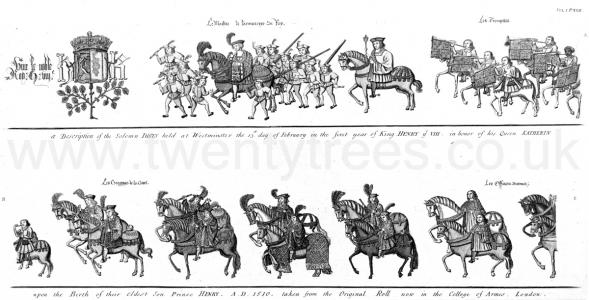
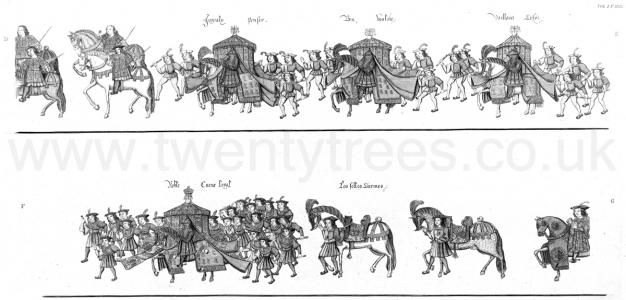
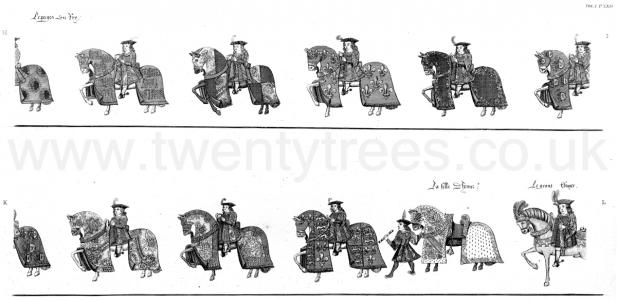
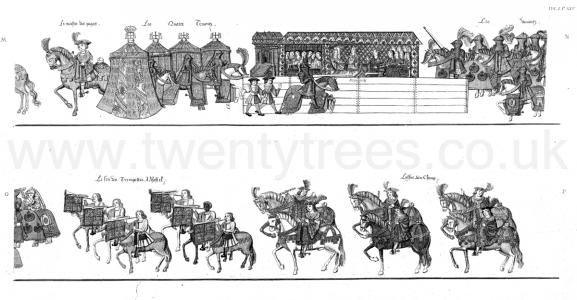
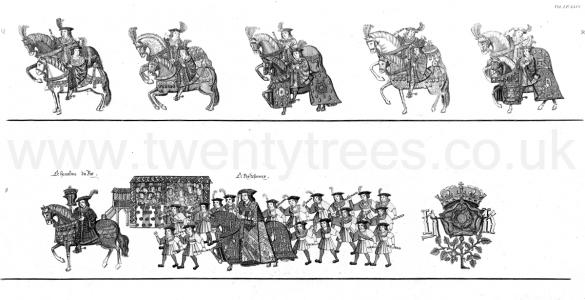
Culture, England, Societies, Society of Antiquaries of London Publications, Vetusta Monumenta Volume 1 Plate 27 Ruins Of Furness Abbey
1727. The ruins of Furness Abbey [Map] in Lancashire. Engraving by George Vertue (age 43) after an untraced drawing originally commissioned by John Montagu, 2nd Duke of Montague (age 37).
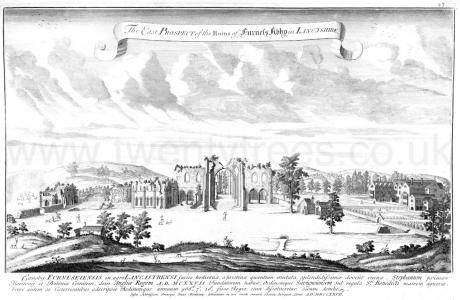
Culture, England, Societies, Society of Antiquaries of London Publications, Vetusta Monumenta Volume 1 Plates 28 to 33 English Barons Letter to the Pope
1729. Copy of the Baron's Letter of 1301, including trickings of the Barons' seals. The letter, addressed to Pope Boniface VIII, asserted Edward I's right to rule over Scotland. Engravings by George Vertue (age 45) after John Bradshaw's [Possibly Judge John Bradshaw] 1629 copy of the herald Augustine Vincent's 1624 copy.

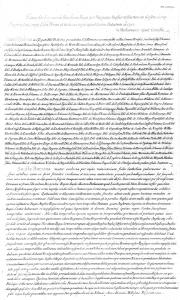
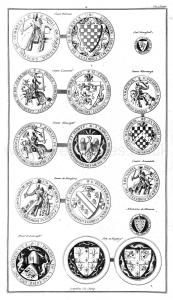
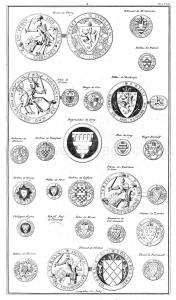
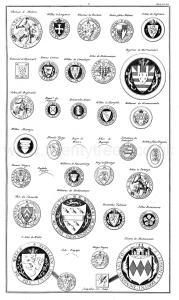
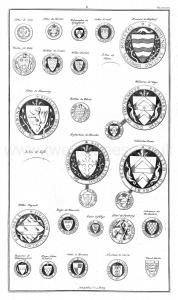
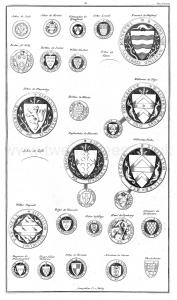
Culture, England, Societies, Society of Antiquaries of London Publications, Vetusta Monumenta Volume 1 Plate 34 Bronze Head of Sulis Minerva Found At Bath
1730. Plate 1.34: Engraving of a gilded Bronze Head of Sulis Minerva Found at Bath in 1727. Engraving by George Vertue (age 46) after Alexander Gordon (age 38). 402 x 282 mm.
Alexander Gordon: Around 1692 he was born at Aberdeen. In Aug 1741 Alexander Gordon sailed for South Carolina as secretary to James Glen, F.S.A., the newly appointed governor of that province. In 1755 he died.
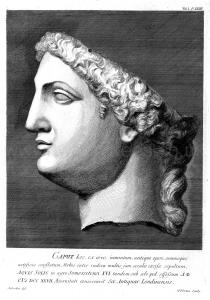
Vetusta Monumenta Volume 1 Plates 35 and 36 Colchester Castle
1732. Plate 1.35. The ruins of Colchester Castle and architectural plans of the site. Engravings by George Vertue (age 48) after "Boul" (probably Cornelis Boel) and Isaac Whood.
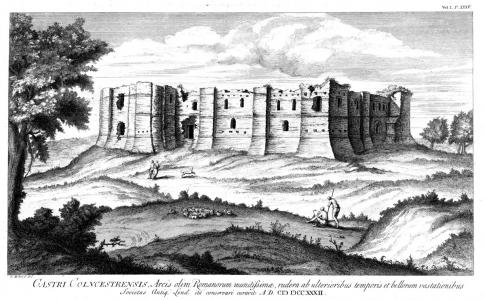
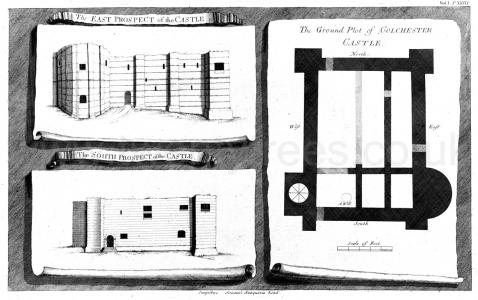
Culture, England, Societies, Society of Antiquaries of London Publications, Vetusta Monumenta Volume 1 Plates 37 and 38 English Coins
1731. Corrected versions of the tables of gold and silver English coins first created by John Sharp, Archbishop of York, in 1697. Engravings by George Vertue (age 47) after Sharp's original tables.
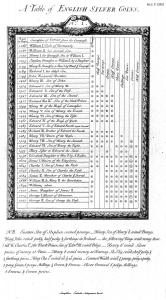

Vetusta Monumenta Volume 1 Plate 39 Tutbury Castle
1733. Plate 1.39 depicts Tutbury Castle. Engraving by George Vertue (age 49) after a drawing originally produced for a survey of the properties of the Duchy of Lancaster conducted by the Chancellor of the Duchy, Ambrose Cave, in 1561.
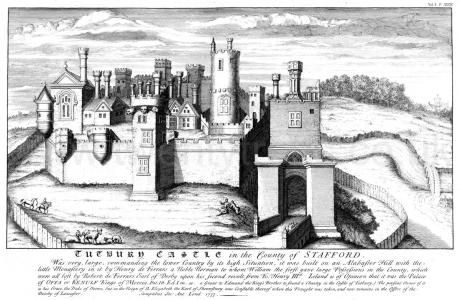
Vetusta Monumenta Volume 1 Plate 40 Melboune Castle
1733. Plate 1.40 depicts Melbourne Castle [Map]. Engraving by George (age 49) Vertue after a drawing originally produced for a survey of the properties of the Duchy of Lancaster conducted by the Chancellor of the Duchy, Ambrose Cave, in 1561.
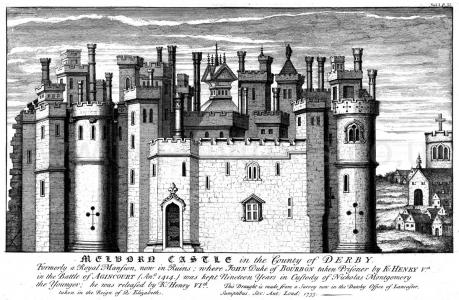
Vetusta Monumenta Volume 1 Plate 41 Lancaster Castle
1734. Plate 1.41. Lancaster Castle [Map] and Priory Church [Map]. Engraving by George (age 50) Vertue after a drawing originally produced for a survey of the properties of the Duchy of Lancaster conducted by the Chancellor of the Duchy, Ambrose Cave, in 1561.
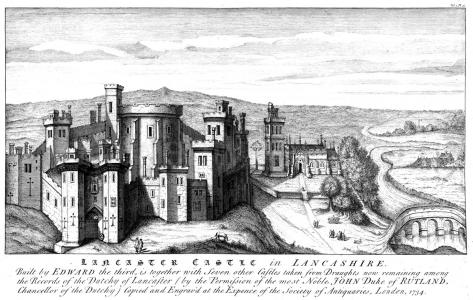
Vetusta Monumenta Volume 1 Plate 42 Pontefract Castle
1734. Plate 1.42. Pontefract Castle [Map]. Engraving by George (age 50) Vertue after a drawing originally produced for a survey of the properties of the Duchy of Lancaster conducted by the Chancellor of the Duchy, Ambrose Cave, in 1561.
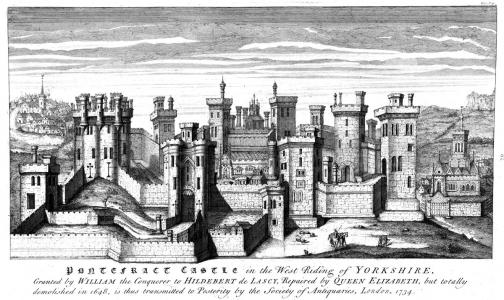
Culture, England, Societies, Society of Antiquaries of London Publications, Vetusta Monumenta Volume 1 Plate 43 English Coins from France and Flanders
1734. Plate 1.43. The golden seal of Edmund, King of Sicily, between 1254 and 1261, a royal of Edward the Black Prince around 1364, a chaise of Edward the Black Prince around 1363), a salute of Henry VI around 1423), an angelot of Henry VI around 1427), a rose noble of Henry VII between 1485 and 1489, a silver jeton of Perkin Warbeck, Pretender around 1494), and a Tournay groat of Henry VIII around 1514. Engraving by George Vertue (age 50) after his own drawings. 459 x 273 mm.


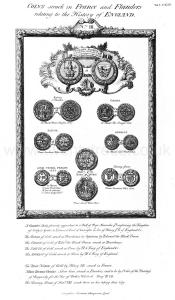
Vetusta Monumenta Volume 1 Plate 44 Knaresborough Castle
1734. Plate 1.44. Knaresborough Castle [Map]. Engraving by George (age 50) Vertue after a drawing originally produced for a survey of the properties of the Duchy of Lancaster conducted by the Chancellor of the Duchy, Ambrose Cave, in 1561.
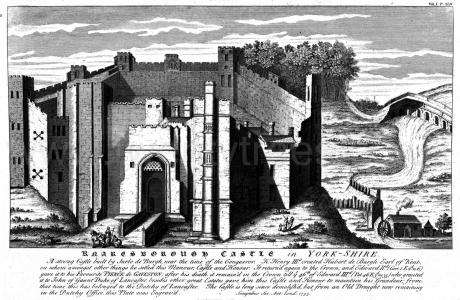
Culture, England, Societies, Society of Antiquaries of London Publications, Vetusta Monumenta Volume 1 Plate 45 Portrait of Thomas Tanner
1736. Plate 1.45. Portrait of Thomas Tanner, Bishop of Asaph. Engraving by George Vertue (age 52) after a portrait of Tanner painted by an unknown artist
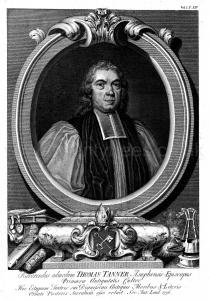
Vetusta Monumenta Volume 1 Plate 46 Tickhill Castle
1737. Plate 1.46. Tickhill Castle [Map]. Engraving by George (age 53) Vertue after a drawing originally produced for a survey of the properties of the Duchy of Lancaster conducted by the Chancellor of the Duchy, Ambrose Cave, in 1561.
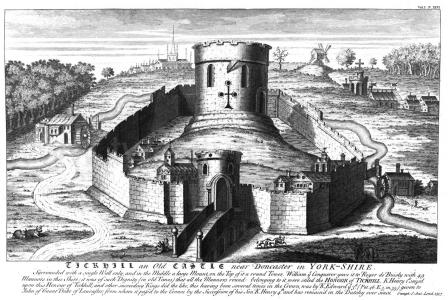
Culture, England, Societies, Society of Antiquaries of London Publications, Vetusta Monumenta Volume 1 Plate 47
1737. Plate 1.47. Roman roads in Yorkshire and immediately adjacent areas originally published by Francis Drake in his Eboracum. Unsigned engraving, likely by George Vertue (age 53), after Drake's original map.
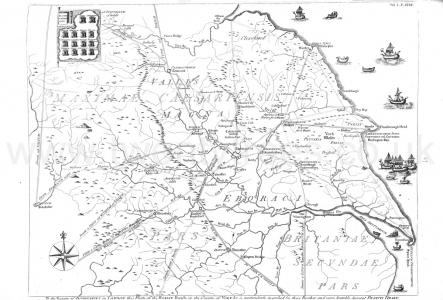
Culture, England, Societies, Society of Antiquaries of London Publications, Vetusta Monumenta Volume 1 Plate 48 Cotterstock Roman Pavement
1737. Plate 1.48. Cotterstock Roman Mosaic. Engraving by George Vertue (age 53) after William Bogdani, George Lynn Sr (age 61), and George Lynn Jr (age 30).
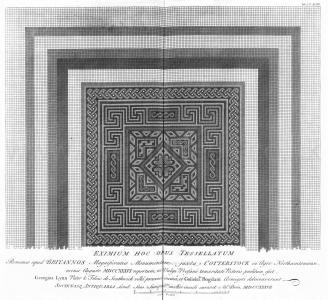
Culture, England, Societies, Society of Antiquaries of London Publications, Vetusta Monumenta Volume 1 Plate 49 Bishop's Chapel
1738. Plate 1.49. Bishop's Palace, Hereford. Drawn by William Stukeley (age 50) in 1721. Engraved by George Vertue (age 54). The chapel was demolished by 1746 except for the north wall, which is adjacent to the cloister.

Culture, England, Societies, Society of Antiquaries of London Publications, Vetusta Monumenta Volume 1 Plates 50 to 52 Roman Pavements at Wellow
1738. Plates 50 to 52. Three mid fourth-century CE Roman mosaic pavements at Wellow, Somerset [Map] the first of which was found by John Aubrey c. 1685. Further investigations of the site were carried out in 1737 by Edmund Prideaux (age 44) and James West, who found the second and third pavements, respectively. Engravings by George Vertue (age 54) after James Vertue (age 78) and James West.
James Vertue: In 1660 he was born.
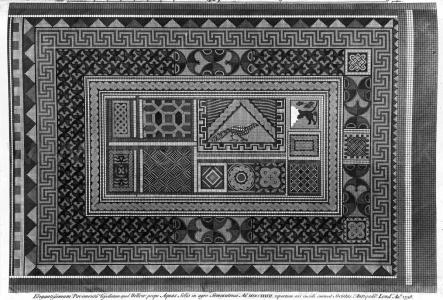
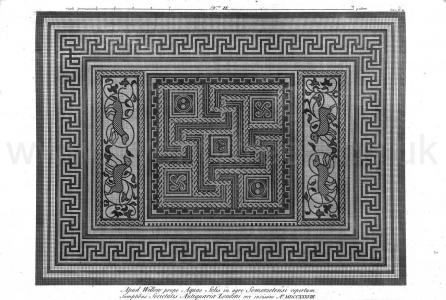
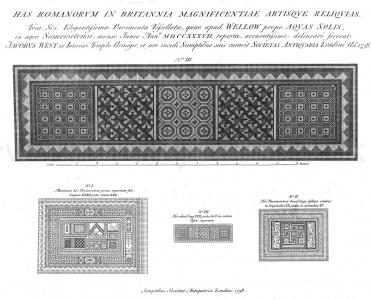
Culture, England, Societies, Society of Antiquaries of London Publications, Vetusta Monumenta Volume 1 Plate 53 and 54 Duchy of Lancaster Seals
1738. Plates 1.53 and 1.54. Sixteen seals dating from the twelfth to the sixteenth centuries, most from the Office of the Duchy of Lancaster, some from the Augmentation Office at Westminster. Engravings by George Vertue (age 54) after his own drawings.
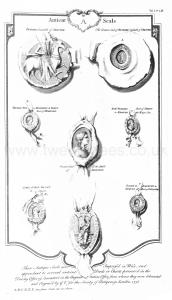
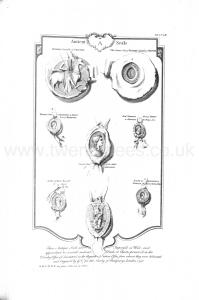
Culture, England, Societies, Society of Antiquaries of London Publications, Vetusta Monumenta Volume 1 Plate 55 Stuart Medals
1739. Plate 1.55. Eight numismatic objects associated with the Stuarts: a gold coin of Mary, Queen of Scots 1555; a silver medal commemorating Mary's marriage to Lord Darnely, featuring Darnley's name before Mary's from 1565; a silver coronation medal around 1604 for Queen Anne; a silver medal for Prince Henry from 1612; two milled gold proof pieces minted for Charles I, around 1630 and 1631-32, and two gold medals based on the same (1639 and unknown). Engraving by George Vertue (age 55) after his own drawings in at least four states between 1723 and 1739.


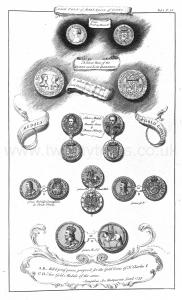
Culture, England, Societies, Society of Antiquaries of London Publications, Vetusta Monumenta Volume 1 Plate 56 English Gold and Silver Coins
1739. Plate 1.56. Thirteen coins minted by English monarchs between the fourteenth and the early-seventeenth centuries: a gold quarter florin of King Edward III, around 1344, a gold escu of King Edward III (after 1337), a half groat of Edward III, before 1369, a half groat of Edward the Black Prince, around 1368-1372, a groat of Edward the Black Prince (c. 1362-72), a gold angel of Henry VI (c. 1470), a quadruple noble of Henry VII, Type 4 (c. 1503-04), a Tournay groat of Henry VIII (c. 1514), a George noble of Henry VIII (c. 1526-29), a sovereign in crown gold of Elizabeth I (c. 1565), a pattern piece for a gold crown of Edward VI (c. 1547), a pattern sixpence of Elizabeth I (1575), and a Portcullis crown of Elizabeth I (c. 1601). Engraving by George Vertue (age 55) after his own drawings.

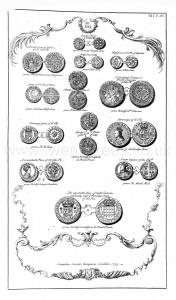
Culture, England, Societies, Society of Antiquaries of London Publications, Vetusta Monumenta Volume 1 Plate 57 Roman Hypocaust at Lincoln
1740. Plate 1.57. Roman hypocaust found beneath the subdeanery near the west side of Lincoln Cathedral and first identified by Thomas Sympson on 10 February 1740. The print incorporates material from Sympson's original letter and plan documenting the discovery. Engraving by George Vertue (age 56) after his own drawings.
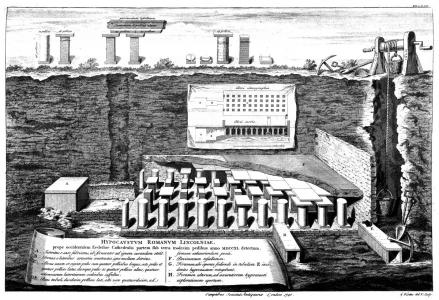
Culture, England, Societies, Society of Antiquaries of London Publications, Vetusta Monumenta Volume 1 Plates 58 to 60 Twenty-Seven Medieval Seals
1741. Plates 1.58 to 1.60. Twenty-seven seals dating from the twelfth to the sixteenth centuries. The seals were held in the Duchy Office of Lancaster and in the Augmentation Office at Westminster. Engravings by George Vertue after his own drawings.
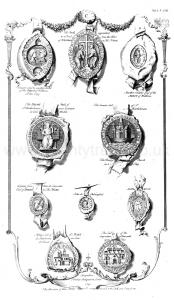
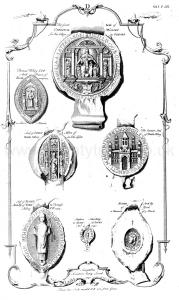
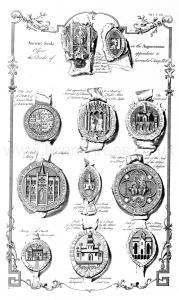
Culture, England, Societies, Society of Antiquaries of London Publications, Vetusta Monumenta Volume 1 Plate 61 Winchester Cross
1741. Plate 1.61. Winchester Cross. Popularly called the "High," "Market," or "Butter" Cross.
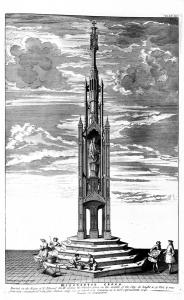
Culture, England, Societies, Society of Antiquaries of London Publications, Vetusta Monumenta Volume 1 Plate 62 Oxford Decree against Papal Jurisdiction
1741. Plate 1.62. Oxford Decree against Papal Juristiction with engravings of the shields of the twelve Oxford colleges extant in 1534, the university's thirteenth-century common seal, and Henry VIII's portrait medal as Fidei Defensor (1545). Engraving by George Vertue (age 57) after his own drawings and a copy of the decree then in the Harleian Library.
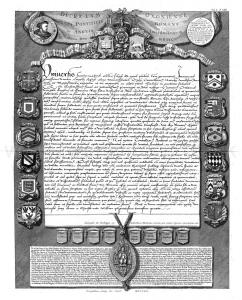
Culture, England, Societies, Society of Antiquaries of London Publications, Vetusta Monumenta Volume 1 Plate 63 Liberties of the Tower of London
1741. Plate 1.63. Plan of the Liberties of the Tower of London [Map].
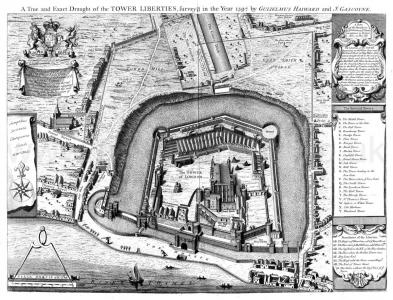
Culture, England, Societies, Society of Antiquaries of London Publications, Vetusta Monumenta Volume 1 Plate 64
1741. Plate 1.64. The Cross at Chichester [Map]. One of the so-called "market-" or "butter crosses," as it appeared (or might have appeared) at several times in the previous half-century, including the west front of the Cross, a plan view of the Cross, and an elevation view of the "highest part" of the Cross. Engraving by George Vertue (age 57) after Augustin Ménageot.
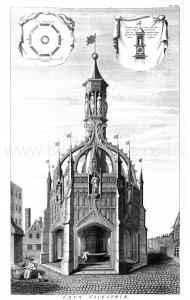
Culture, England, Societies, Society of Antiquaries of London Publications, Vetusta Monumenta Volume 1 Plate 65 Roman Net Fighters
1743. Plate 1.65. Two works of art in different media that depict the type of Roman gladiator known as a retiarius or net-fighter. The upper half reproduces a seventeenth-century drawing by Pietro Santi Bartoli of a late-third or early-fourth-century CE Roman mosaic uncovered in Rome in 1670. The lower half depicts the sculptured fragment of a second-century Romano-British stone frieze, possibly from a tomb, that was found during construction work in Chester, UK in 1738. Engraving by George Vertue (age 59) after Pietro Santi Bartoli (upper half) and his own drawing (lower half).
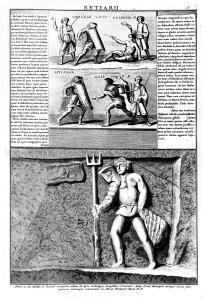
Culture, England, Societies, Society of Antiquaries of London Publications, Vetusta Monumenta Volume 1 Plate 66 Robert Cotton with Genesis Fragments
1744. Plates 1.66 to 1.68. Robert Cotton with Genesis Fragments. Reproduction of a portrait from around 1626 of Robert Cotton and fragments of the Cotton Genesis manuscript by Cornelius Johnson. Plates 1.67-1.68 depict twenty-one fragments from eighteen folio pages of the Cotton Genesis collated with transcriptions from the Codex Vaticanus. Engravings by George Vertue (age 60) after the original portrait and his own watercolors of the Cotton Genesis fragments.
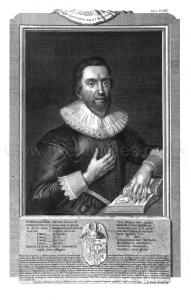
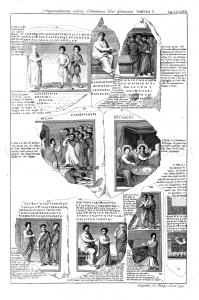
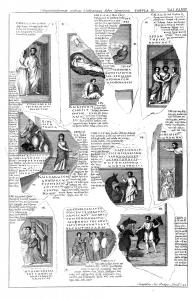
Culture, England, Societies, Society of Antiquaries of London Publications, Vetusta Monumenta Volume 1 Plate 69 Engraving of a 1497 Standard of Weights and Measures
1746. Plate 1.69. Engraving of King Henry VII's 1497 Standard for Weights and Measures based on an original parchment that was pasted on an oak table formerly in the Treasury of the King's Exchequer at Westminster and in the collection of Edward Harley, 2nd Earl of Oxford and Mortimer. Engraving by George Vertue (age 62) after his own drawing.
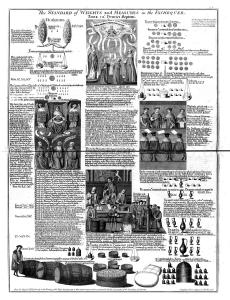
Culture, England, Societies, Society of Antiquaries of London Publications, Vetusta Monumenta Volume 1 Plate 70 Court of Wards
1741. Plate 1.70. A painting of a session of the Court of Wards and Liveries at a point in time during the many years that William Cecil, Lord Burghley, held its mastership. Those included in the picture are: George Goring died 1594 and Thomas Seckford died 1587. The engraving indicates the painting was commissioned by Charles Lennox 2nd Duke Richmond (age 39).

